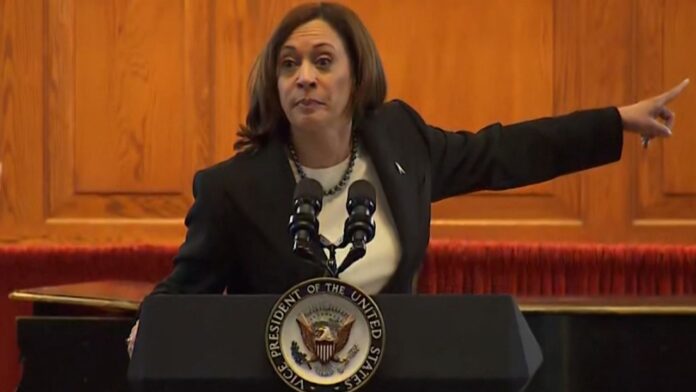As April 2025 unfolds, Kamala Harris has stepped back into the public eye with a bold speech that’s got everyone talking. On April 28, she delivered a stinging critique of President Donald Trump’s policies at a San Francisco event hosted by Emerge America, marking her most significant public appearance since her 2024 presidential election loss. Harris didn’t hold back, slamming Trump’s economic agenda and warning of threats to American institutions. This fiery reemergence isn’t just about settling scores—it’s a calculated move as she weighs a potential run for California governor in 2026. With her political future hanging in the balance, Harris is navigating a delicate path, balancing her national profile with ambitions closer to home. Let’s dive into what’s driving her comeback and what it means for her next chapter.
Kamala Harris Condemns Trump’s Agenda
Harris’s San Francisco speech was a masterclass in reasserting relevance. Speaking to a crowd eager for Democratic leadership, she accused Trump of undermining Social Security, Medicare, and the Department of Education through his administration’s push for Project 2025, a controversial conservative blueprint. “Courage is contagious,” she declared, urging Americans to resist what she called “unconstitutional threats.” Her words echoed a sentiment from her April 5 “Hands Off!” protest response, where she praised demonstrators for standing firm against Trump’s policies. This isn’t just rhetoric—Harris is positioning herself as a defender of progressive values, a role that could resonate deeply in California’s Democratic stronghold. Her allies say she’s horrified by institutions buckling under Trump’s influence, from universities to law firms, including her husband’s, which recently struck a deal with the administration.
Her critique comes at a pivotal moment. After a relatively quiet few months, Harris is reengaging with a party still reeling from 2024’s electoral defeats. Her speech wasn’t just about Trump—it was a signal she’s not fading away. She’s been strategic, meeting with firefighters after Los Angeles wildfires and accepting an NAACP award in February, all while keeping her options open. The question now is whether this momentum carries her toward Sacramento or back to the national stage.
Kamala Harris and the California Governor Race
The buzz around Kamala Harris running for California governor is growing louder. With Governor Gavin Newsom term-limited, the 2026 race is wide open, and Harris is the name on everyone’s lips. A recent POLITICO and UC Berkeley Citrin Center poll shows California Democrats are enthusiastic about her potential candidacy, with 33% feeling “joyful” and 41% “mostly excited.” If she jumps in, she’d likely clear the field—former Los Angeles Mayor Antonio Villaraigosa is one of the few who’d challenge her in a runoff. But not everyone’s on board. Policy influencers in the state are lukewarm, with 36% feeling “indifferent,” and some Latino and Asian voters express irritation, hinting at her uneven local support.
Here’s a quick look at the dynamics of the 2026 race:
- Crowded Field: Over a dozen Democrats, including Xavier Becerra and Katie Porter, are circling the race.
- Harris’s Edge: Her national profile and fundraising prowess make her a frontrunner, but her 2019 presidential run showed weaker California support.
- Decision Timeline: Harris has until late summer to decide, balancing a gubernatorial bid against a possible 2028 presidential run.
Her hesitation has frustrated some Democrats, who argue California needs leaders to step up now against Trump’s policies. Yet, her allies, including former Virginia Governor Terry McAuliffe, are urging her to seize this chance to lead the nation’s most populous blue state.
A Strategic Comeback or a Risky Gamble?
Harris’s reemergence is a high-stakes play. After her 2024 loss, she was “completely shocked,” according to a new book, Fight, which details her campaign’s missteps. She blamed President Biden’s late exit for her 107-day sprint, a narrative that’s sparked debate within the party. Some Democrats, like Representative James Clyburn, point to campaign errors, while others see her as a scapegoat for broader failures. Her current strategy—targeted speeches, selective appearances, and social media jabs at Trump and Elon Musk—shows she’s learned from past mistakes. But the governor’s race isn’t a sure bet. California faces daunting challenges: housing shortages, homelessness, and budget deficits. Critics, like Republican candidate Steve Hilton, call her a “rejected machine politician,” arguing she’s more about identity than ability.
On the flip side, Harris sees the governorship as a platform to push back against Trump and defend Democratic priorities. Her experience as California’s attorney general and U.S. senator gives her a deep understanding of the state’s issues. Plus, her fundraising clout—she’s headlining a Democratic National Committee event in New York next month—could overwhelm competitors. The question is whether she can reconnect with California voters who’ve been skeptical before.
What’s Next for Kamala Harris?
As Kamala Harris charts her path, the political world is watching closely. Her San Francisco speech and earlier Dana Point remarks show she’s not backing down. “I’m not going anywhere,” she told Black women leaders in April, a promise she’s backing with action. Whether she runs for governor or eyes 2028, Harris is staying in the fight. Her critique of Trump resonates with Democrats desperate for a unifying voice, but her success depends on bridging divides within her party and state. If she enters the governor’s race, she’ll need to convince voters she’s not just a national figure but a leader ready to tackle California’s gritty challenges. For now, Harris is keeping us guessing, blending defiance with deliberation. One thing’s clear: her next move will shake up the political landscape, and we’ll be watching every step.
